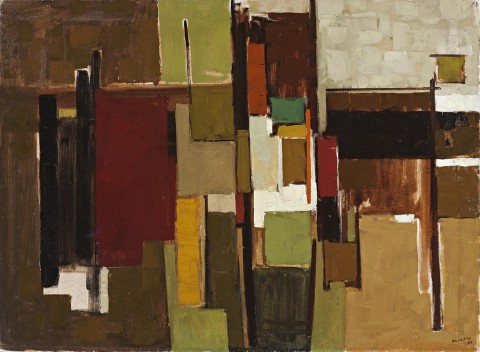COMPOSIZIONE, 1959
YVONNE AUDETTE
oil on canvas
73.5 x 100.0 cm
signed and dated lower right: Audette / 59
artist’s stamp verso
bears inscription verso: 3 / H. 283 / 5045 on Galleria Schettini stamp
Galleria Schettini, Milan (stamped and label attached verso, stock no. F.S. 7513)
Galleria Michelangelo, Bergamo (stamped and label attached verso)
Sotheby's, Sydney, 21 March 2005, lot 3
Company collection, Sydney
The generation of Australian artists born around the turn of the nineteenth century counted among its ranks a significant number of successful women artists including Grace Cossington Smith, Christian Waller and Grace Crowley. Similarly, many women who came of age during the 1960s and 70s forged successful artistic careers, taking advantage of women’s liberation and other social freedoms of the time. Born between the wars, Yvonne Audette is however a rare female member of the generation for whom both the expectations of women and opportunities for them beyond marriage and motherhood were limited.1
Following studies in Sydney at the Julian Ashton Art School, with Lyndon Dadswell at East Sydney Technical College and independent classes with both Desiderius Orban and Godfrey Miller, Audette left Australia in September 1952. Like so many young Australian artists she wanted to see the great art of the world, but unusually for the time she sailed to New York rather than London or Paris. While this decision was influenced by her American-born parents’ agreement to provide financial support if she went there rather than to Europe, it proved to be fortuitous, coinciding with the emergence of the New York School of Abstract Expressionist painting which had a profound effect on her artistic development. Audette gained first-hand exposure to the work of the major exponents of the movement, including Willem de Kooning (whose studio she visited in 1953), Robert Motherwell and Mark Tobey and while her training had been in the academic figurative mode, at this moment she began to move towards abstraction. Notes in sketchbooks from this time document her thinking, ‘architectural structure of de Kooning. Let go of all figuration – Calligraphic gesture of Kline … Calligraphic work with free gesture has endless possibilities’ and the gentle exhortation, ‘Don’t get too sophisticated’.2
Audette left New York in May 1955 and after travelling in Europe, arrived in Italy where she established a studio in Florence.3 Welcomed into a community of successful practising artists including Arnaldo Pomodoro and Lucio Fontana and stimulated by their example, she worked hard, drawing on her experiences and range of creative influences to develop a mature abstract style. While Audette’s art has continued to evolve throughout her career, it is characterised by the textural layering of line and form, dextrous mark-making and a lyrical use of colour, a unique amalgam of contemporary local and international influences, which make it distinctive within twentieth-century Australian art. Painted in a range of earthy browns, blacks and greens that evoke the landscape, Composizione, 1959 comprises a series of variously scaled squares and rectilinear forms combined to create a carefully balanced central structure. The application of the paint in short staccato brushstrokes that echo the geometric components of the painting, enlivens the surface, adding to a sensation of movement within the overall pictorial equilibrium. In 1959 Audette travelled to Turkey and the Middle East, to France where she met the abstract artist Maria Elaina Vieira da Silva, and then to America where the scale and vitality of the New York art scene both confirmed and reinvigorated her direction to pursue painting as ‘a means to grasp the invisible, the mysterious logic of things’.4 As she later wrote, ‘I wish to substitute the more obvious visual associations for the more tenuous processes which have the power to awaken an inner vision. My imagery rests just below the horizon of recognition’.5
1. See Ewington, J., Yvonne Audette: Abstract Paintings 1950s & 1960s, exhibition catalogue, Queensland Art Gallery, Brisbane, 1999, pp. 19 – 20
2. The artist quoted in Grant, K., Yvonne Audette: Different Directions 1954-1966, exhibition catalogue, National Gallery of Victoria, Melbourne, 2008, unpaginated
3. Audette lived in Florence until 1963 when she relocated to Milan before returning to Australia permanently in 1966.
4. The artist quoted in James, B., ‘Yvonne Audette: The Later Years’, Heathcote, C., et. al., Yvonne Audette: Paintings and Drawings 1949-2003, Macmillan, Melbourne, 2003, p. 152
5. ibid.
KIRSTY GRANT
